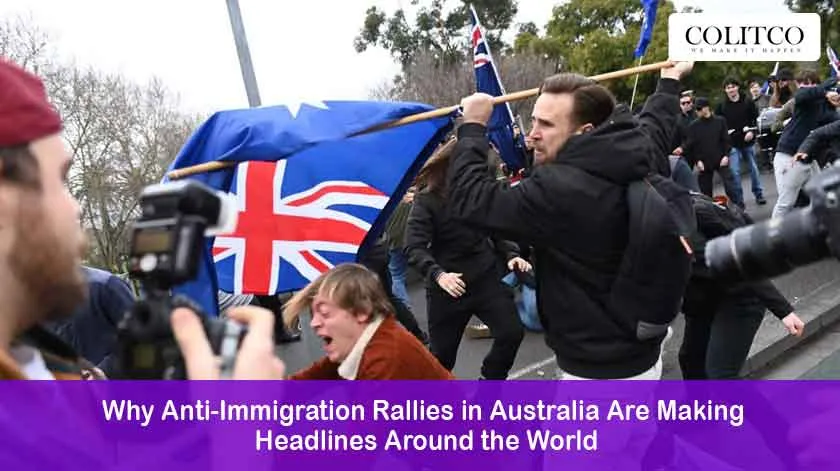Thousands of people joined anti-immigration rallies in Australia on Sunday, events that the government condemned as divisive and linked to neo-Nazi groups. Demonstrations were staged in Sydney, Melbourne, Adelaide, and regional centres, highlighting growing tensions around migration and national identity.
March for Australia Events
The protests, called “March for Australia,” were organised in various state capital cities and towns. The movement seeks to “demand an end to mass immigration,” the group’s website states. Organisers spoke of concerns about housing, wages, infrastructure, hospitals, and community identity.

Thousands gather in Sydney during anti-immigration rallies
Protesters walked along the Sydney marathon course where 35,000 runners were racing. Between 5,000 and 8,000 turned out at the Sydney protest, police estimated. Wearing national flags, many had turned up.
In Melbourne, aerial footage broadcast by the ABC showed thick crowds of people in the city centre. News indicated police used pepper spray during the protest, though Victoria Police were unable to verify the occurrence within the timeframe. Adelaide also saw protests, and local media estimated 15,000 individuals took part in rallies and counter-protests in total.
Social Media Advertising and Response
The marches were promoted on social media, and Valerie (@AussieVal10) shared the following posts:
“Cute Aussies. You’ve gone viral. You’re trending on international news. Well done. Look at those gorgeous Aussie flags waving.”
My beautiful Aussies. You have gone viral. You feature heavily on international news.
Well done ❤️❤️❤️
Look at those gorgeous Aussie flags 🇦🇺🇦🇺🇦🇺 waving. pic.twitter.com/n7QjwiNIgL
— Valerie💐 (@AussieVal10) September 1, 2025
Some other messages expressed support for the cause and stated that the protests were peaceful. Some called the protests a defence of future generations, while others criticised media coverage for unfairly representing participants.
Counter-Protests and Opposition
In Sydney, there were counter-protests staged by the Refugee Action Coalition. There were hundreds of people who participated, carrying placards calling for migrants and against racism. The spokesperson remarked that the protest was an indication of “the depth of disgust and anger about the far-right agenda.”

Police presence at Melbourne rally amid rising tensions
In Melbourne, there was a pro-Palestine protest near the anti-immigration march, which resulted in hostile exchanges between groups. Police also used riot police to control crowds.
Opposition MPs like One Nation senator Pauline Hanson and federal MP Bob Katter addressed rallies. Katter was reported to have been “swarmed with hundreds of supporters” at Queensland rally, local media said.

Refugee advocates counter anti-immigration rallies in Sydney
Government Condemnation
The federal government condemned the rallies, blaming them on far-right groups and hate speech. A senior Labour minister, Murray Watt, declared the rallies “not about increasing social harmony” and said they were “organised and promoted” by neo-Nazi groups.
Home Affairs Minister Tony Burke also stated that the government will not fund events “that divide and undermine social cohesion.” He added, “We stand with modern Australia against these rallies—nothing could be less Australian.”
Dr. Anne Aly, the multicultural affairs minister, also declined to endorse the rallies, calling them “far-right activism rooted in racism and ethnocentrism.” She stated that the government would nonetheless be standing behind migrant communities.
Legal and Political Context
The marches came at a time when Australia is seeing growth in right-wing extremism. Laws banning the Nazi salute and associated symbols have come into force this year following antisemitic incidents since late 2023. Suspected neo-Nazis were reported to have addressed crowds in Melbourne, including Thomas Sewell, who addressed a crowd on the Parliament House steps.
Crime and community safety issues were also shared by the participants. Sydney demonstrator Glenn Allchin told Reuters that he was calling for an “immigration slowdown” to the effect that the country was “bursting at the seams.” His given reasons for doing so were housing shortages and hospital wait times.
Australia’s Demographics and Migration
Australia is a highly multicultural country. Official figures indicate that every second resident is either born overseas or has a parent who was born abroad. By June 2024, the population was 27.2 million, of which 8.6 million individuals were born abroad.
The biggest foreign-born groups come from England, India, China, and New Zealand. The fastest growth in migration has been experienced by Indians since 2014. The share of foreign-born residents went up from 30.7% in 2023 to 31.5% in 2024.
Organisers’ Concern
The March for Australia campaign has put a wide-ranging agenda on its home page. Among the issues listed are culture, wages, traffic congestion on roads, availability of water, affordable housing, and environmental stress. Hospitals, roads, and other infrastructure are cited as also subject to pressure.
Placards were worn by protesters highlighting these issues. In one of the demonstrations, a placard expressed solidarity with Dezi Freeman, a conspiracy theorist who stands accused of shooting two police officers. Freeman is currently the target of a manhunt.

Marchers display national symbols during rallies nationwide
Also Read: Australia Migration Issue: Housing, Population Growth, and Policy Dispute
Final Thoughts
The anti-immigration rallies in Australia drew thousands to city centres and regional towns, sparking condemnation from the government and counter-protests. With organisers calling for mass immigration to be brought to a halt and officials reporting threats of extremist participation, the rallies were a sign of widening divides in a country where migration has shaped national identity.
FAQs
- Were kangaroos part of the rallies?
No, they weren’t. But given the number of flags and jumping crowds, some people joked it looked like it. - Did Australians really march in Japan?
Not quite. A few social media users claimed it, but what’s true is Japan just announced a large immigration plan, which drew comparisons online. - Why does the media keep mentioning “Neo-Nazis”?
Because some extremist groups were spotted joining the rallies. But not everyone waving a flag was part of that. - Was Vegemite served at the protests?
Sadly, no. But a few witty Aussies joked online that Vegemite should have been the official sponsor. - What happens next — another rally or a BBQ?
Both, probably. Organizers have already hinted at more marches, and if you know Australians, there’s always a BBQ somewhere.












